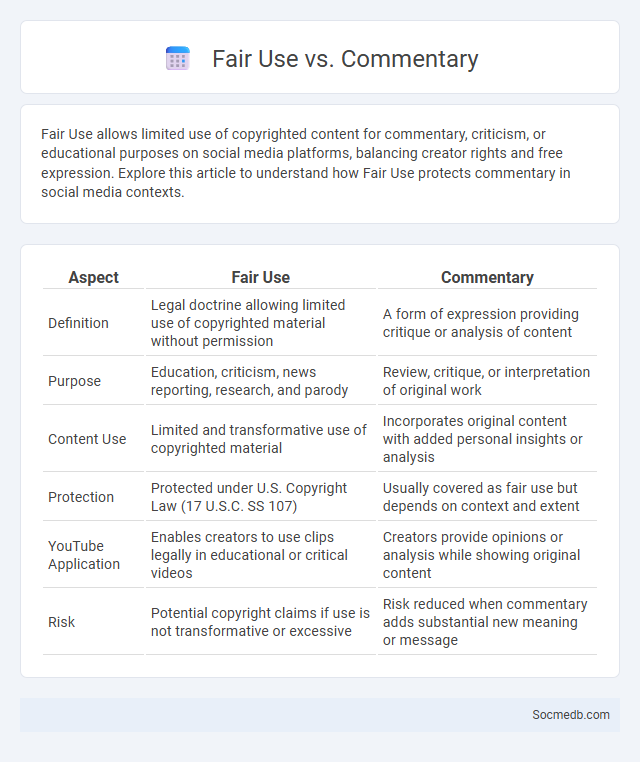
Photo illustration: Fair Use vs Commentary
Fair Use allows limited use of copyrighted content for commentary, criticism, or educational purposes on social media platforms, balancing creator rights and free expression. Explore this article to understand how Fair Use protects commentary in social media contexts.
Table of Comparison
| Aspect | Fair Use | Commentary |
|---|---|---|
| Definition | Legal doctrine allowing limited use of copyrighted material without permission | A form of expression providing critique or analysis of content |
| Purpose | Education, criticism, news reporting, research, and parody | Review, critique, or interpretation of original work |
| Content Use | Limited and transformative use of copyrighted material | Incorporates original content with added personal insights or analysis |
| Protection | Protected under U.S. Copyright Law (17 U.S.C. SS 107) | Usually covered as fair use but depends on context and extent |
| YouTube Application | Enables creators to use clips legally in educational or critical videos | Creators provide opinions or analysis while showing original content |
| Risk | Potential copyright claims if use is not transformative or excessive | Risk reduced when commentary adds substantial new meaning or message |
Understanding Fair Use: A Legal Overview
Fair use is a legal doctrine allowing limited use of copyrighted material without permission for purposes like commentary, criticism, and education on social media platforms. Key factors influencing fair use claims include the purpose of use, the nature of the copyrighted work, the amount used, and the effect on the market value. Understanding these criteria helps content creators navigate copyright laws while sharing and remixing content responsibly.
Defining Commentary in Content Creation
Defining commentary in content creation involves providing insightful analysis, personal opinions, or critical perspectives on a specific topic or event within social media posts. This type of content enhances audience engagement by encouraging discussion and offering unique viewpoints that differentiate creators from others. Effective commentary blends authenticity and expertise, contributing to a more dynamic and interactive digital presence.
Key Differences: Fair Use vs Commentary
Fair use in social media allows limited use of copyrighted content without permission primarily for purposes such as criticism, news reporting, or education, often evaluated by factors like purpose, nature, amount, and market effect. Commentary involves expressing personal opinions or analysis directly about the content, often incorporating transformative elements to add new meaning or message. Key differences hinge on fair use being a legal defense for specific uses of copyrighted material, while commentary emphasizes original interpretation or critique that transforms the original work.
The Four Factors of Fair Use
Social media content creators must navigate the Four Factors of Fair Use to avoid copyright infringement, which include the purpose of use, the nature of the copyrighted work, the amount used, and the effect on the market value. Your posts or shares should prioritize transformative use, such as commentary or criticism, to strengthen fair use claims. Understanding these factors helps protect your content while respecting the original creators' rights on platforms like Instagram, TikTok, and YouTube.
How Commentary Fits Within Fair Use
Commentary qualifies as fair use by providing criticism, analysis, or explanation of copyrighted material without substituting the original work. Social media platforms enable users to create transformative content such as reviews, parodies, or discussions, which often meet fair use criteria by adding new expression or meaning. Courts assess factors like purpose, nature, amount used, and market impact to determine if commentary on social media falls under fair use protection.
Common Misconceptions About Fair Use
Common misconceptions about fair use on social media include the belief that all content shared qualifies as fair use, which is incorrect as it depends on factors like purpose, nature, amount, and market effect. Many users assume that giving credit automatically protects them from copyright infringement, but attribution alone does not guarantee fair use protection. Understanding these nuances helps you navigate content sharing responsibly and avoid potential legal issues.
Real-World Examples: Fair Use and Commentary in Action
Real-world examples demonstrate how fair use protects commentary on social media platforms by allowing users to critique, review, or parody copyrighted content without infringement. Notable cases include reviews on YouTube that incorporate clips from movies or music to support transformative commentary, ensuring creators can engage in meaningful discussions. To safeguard your content and respect others' rights, understanding fair use principles is essential for navigating social media legally and ethically.
Legal Risks and Safeguards for Creators
Social media creators face significant legal risks including copyright infringement, defamation, and privacy violations, which can lead to costly lawsuits and account suspensions. To mitigate these risks, creators should implement safeguards such as obtaining proper licenses, using original content, and clearly disclosing sponsored posts to comply with FTC guidelines. Employing contracts and understanding platform-specific policies further protect creators from legal liabilities and ensure sustainable digital presence.
Best Practices for Utilizing Fair Use in Commentary
Effective utilization of fair use in social media commentary requires a clear understanding of transformative use, focusing on adding new expression or meaning to the original content. Emphasizing brevity and relevance while limiting the amount of copyrighted material used ensures compliance with fair use standards. Proper attribution and a critical, analytical approach strengthen the legitimacy of commentary without infringing on copyright laws.
Navigating Copyright Challenges in Digital Media
Navigating copyright challenges in digital media requires understanding complex intellectual property laws that govern content sharing on social platforms like Instagram, YouTube, and TikTok. Content creators must implement robust strategies such as obtaining licenses, using royalty-free media, and leveraging digital rights management tools to avoid infringement claims. Awareness of platform-specific policies and timely content monitoring helps mitigate risks and ensures compliance with copyright regulations.
 socmedb.com
socmedb.com